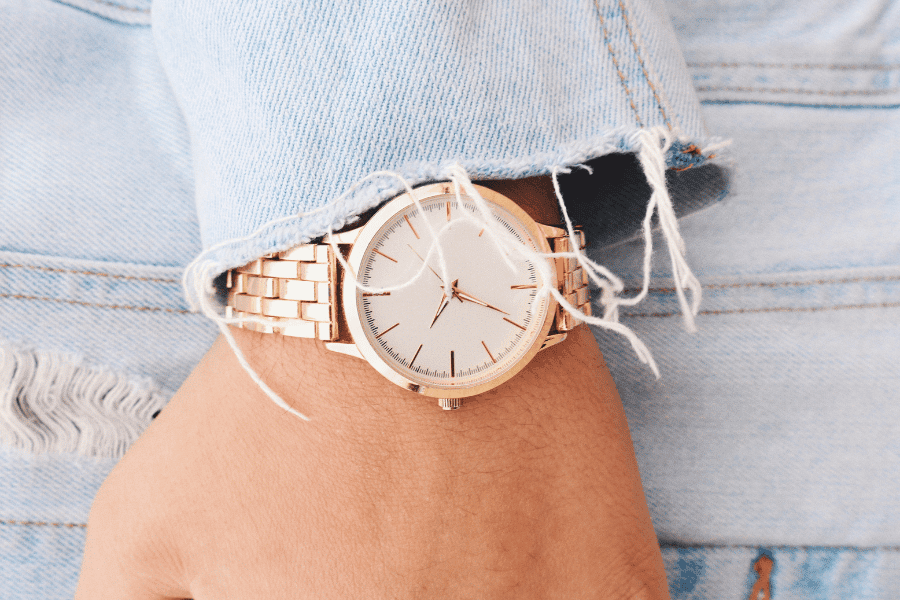
10 Types of Watches You Must Know About + 14 Types of Watch Straps
Posted on | by Milos Djordjevic
Did you know there are 10 types of watches to choose from? Naturally, these types aren’t independent of each other, but you can mix and match styles and functionalities to get the perfect watch for you.
This article will tell you everything there is to know about watches, which style is the best for you, and what specific terminology like ‘automatic,’ ‘quartz,’ or ‘diver’s watch’ really means.
Watch Types by Function and Style
The most popular way to differentiate between watches is style. There are nine different types of watch, from diver’s watches to smart ones, to look out for.
1. Dress Watch
A dress watch is a perfect option for formal or semi-formal occasions. It’s one of the best-looking watches on our list, and that’s by design: dress watches look sophisticated and elegant enough to work together with all types of formal attire.
You won’t ever see dress watches with digital displays—in this case, looks absolutely trump functionality. If you need something to pair with a black-tie suit, a dress watch is the way to go.
2. Aviator Watch
The first aviator watch, the Cartier Santos, was built in the early 1900s for aeroplane pilots, and since then, it has become one of the most famous watch styles in the world.
These watches are all about functionality. They sport bold markers to make telling the time at a glance easier. You can also find additional features, such as chronographs, on these models.
Understandably, some aviator watch styles have a strong military heritage. For example, the German airforce first gave ‘Flieger’ type watches to their bomber pilots during World War II.
3. Field Watch
Field watches are among the most exciting watch types due to their heritage. They are also sometimes called military watches, which tells you a lot about their history.
First worn by army personnel during the World Wars, they have gained incredible popularity, which lasts to this day, and for good reason. They’re rugged, easy to read, and incredibly durable.
If you’re looking for something to accompany you while exploring the great outdoors, you’ll love field watches.
4. Chronograph Watch
Chronograph watches are wrist watches with a stopwatch function and several subdials for various purposes.
While they can look beautiful and can be very useful in some instances, they’re quickly becoming obsolete due to smartphones.
5. Diver’s Watch
Diver’s watches are among the most unique types of wrist watches. They’re built to resist high water pressure when diving. You can quickly tell diver’s watches apart thanks to their resistance rating, indicated in metres or feet and engraved on the dial.
They’re also often shock- and magnetic-resistant, which results in a bulkier, heavier, and more expensive watch. This also means that the end product will look sturdy, tough, and ‘manly-looking,’ which can be a massive plus for many wearers.
6. GMT Watch
If you often travel between time zones, a GMT watch might help you immensely. The GMT in the name stands for Greenwich Meridian Time, and they do exactly what you’d think: provide the time of day between two different time zones.
Among the least-known men’s watch types, GMT watches are helpful for pilots or people that often need to communicate with people on the other side of the globe.
7. Atomic Radio-Controlled Watch
Atomic radio-controlled watches are the most precise wrist watches, since they actively sync with the atomic clock—the most accurate clock on Earth—through radio waves.
These watches are a bit costly and may not even work as intended in some parts of the world—those where the clock can’t pick up the relevant radio signals, like Africa or South America—but if you’re looking for accuracy, this is the best on the market.
8. GPS Watches
GPS Watches are often mistaken for smartwatches, but these are two completely different types of watches altogether. Namely, smartwatches offer much more than regular GPS watches.
So, what does a GPS watch do? It keeps track of specific GPS-related data, like how far you’ve run or cycled, and often has a heartbeat sensor, helping you track your performance on various paths and trails.
These watches usually come with a digital screen and are water-resistant. Also, thanks to how widespread GPS technology is, these watches will work in places where atomic radio-controlled watches might not.
9. Smartwatches
Finally, we’ve reached the final frontier: smartwatches. These little technological marvels are tiny cell phones that can do whatever a full-size smartphone does, but in a smaller form.
For example, you can receive calls on these devices, play music, watch videos, look at photos, and tell the time. The most popular smartwatches are the Samsung Gear and Apple Watch, excellent options for new and seasoned users alike.
Manufacturers often allow users to choose between numerous types of watch straps for their smartwatch.

10. Racing Watches
As the name suggests, racing watches are used by racers to tell the time during competitions. Racing requires incredible precision and accuracy in time-telling, so racing watches are often the cream of the crop when it comes to that.
Usually, they come with a high-contrast dial and a chronograph. Vintage pieces may also come with rally-style straps and angled case orientation.
Watch Movement Types
You can differentiate watches by how they move. Today, we have three main types of watch movement: mechanical, automatic, and quartz.
Mechanical
The earliest type of wrist watches available were mechanical ones. To make a mechanical watch work, you have to wind it.
When wound, the watch will build momentum in the mainspring. That momentum gets released in precise intervals, regulated by the watch’s internal mechanism—mainly by a mechanism called ‘escapement.’
These watches can last 40–50 hours between charges.
Automatic
Automatic watches are among the most loved types of watches for men and women alike. You power these watches through your wrist’s movement, which spins a rotor that stores energy in the watch’s mainspring. However, these wrist watches can still be manually wound if necessary.
Due to their weighted rotor mechanism, they feel much more hefty and sturdy compared to quartz or mechanical watches. These features, paired with their reliability, rendered mechanical watches obsolete for many.
Quartz
Quartz watches are simple, convenient, and very precise. Instead of kinetic energy, they rely on a battery which generates an electric current that vibrates the quartz inside the watch at a specific frequency.
Types of Watch Straps
Yet another way to differentiate between watches is through the strap. Did you know there are 14 main types to choose from? Let’s discover them all.
1. Canvas Straps
Canvas straps are tough, comfortable, and perfect for field and tool watches. They can be built from synthetic or natural materials.
2. NATO Straps
As the name suggests, these straps have a military heritage tied to the North Atlantic Treaty Organisation and, more specifically, the British Army. Their signature striped design and comfortable fit are loved by wrist watch enthusiasts and soldiers alike.
3. Rubber Straps
Among watch strap types, rubber straps are often considered the most uncomfortable and brittle and, as such, get instantly shunned by most people.
However, that stereotype stems from earlier rubber straps, and modern ones are extra comfortable, durable, and beautiful.
4. Dress Leather Straps
Dress leather straps are associated with dress watches and come in various styles and materials. Generally, they’re thin, elegant, and subdued, which works excellently with black-tie outfits.
5. Casual Leather Straps
Casual leather straps are bulkier and more eye-catching than dress leather straps. You can easily pair them with anything, from simple, everyday clothes to a more elegant outfit.
6. Oyster Bracelet
Among watch bracelet types, Oyster bracelets work best on sports watches. They were designed and popularised by Rolex and used by them since the late 1930s.
7. Jubilee Bracelet
Also associated with Rolex, Jubilee bracelets have a polished centre with brushed outer links and are most often found on diver’s watches.
8. Mesh Bracelet
Mesh bracelets were first introduced in the 1970s by the brand Omega, which claimed that they were ‘shark-proof.’ While the validity of this statement is shaky, these bracelets still look dashingly fashionable to this day.
9. Engineer Bracelet
Engineer bracelets are chunky, heavy, and made of five rows of links. Seiko is one of the most famous watch brands that sell engineer bracelets.

10. Sailcloth Straps
These straps are built from nylon-based sail-making material, which is durable and attractive.
11. Zulu Straps
Zulu straps look similar to NATO ones, but they’re thicker and more streamlined.
12. Rally Straps
First made for race drivers, rally straps include perforation to let the skin underneath breathe.
13. Perlon Straps
Perlon is a lightweight, nylon-based material. These straps allow the user to place the tang in any spot in the weave.
14. Bund Straps
Bund straps have a distinctive block of leather behind the watch’s case. They were first built for World War II German bomber pilots to insulate the wearer’s wrist.
Conclusion
As you can see, there are many types of watches to choose from, and it can all get confusing quickly. If you don’t know what you’re looking for, you might waste a lot of money and time buying a watch you won’t ever put on.
We hope you found just what you were looking for thanks to this guide. From vintage mechanical models to modern, radio-controlled ones, the perfect watch for you is out there!